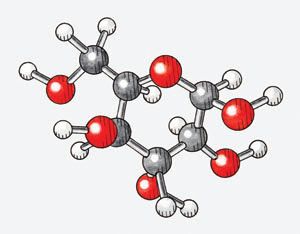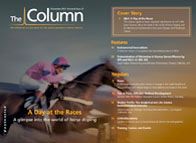Sweet potential
A group of researchers led by Dr S. Habtemariam from the University of Greenwich, London, UK,1believe they have identified potential sources of new natural‑origin drugs to treat diabetes that may have reduced adverse clinical side effects.

A group of researchers led by Dr S. Habtemariam from the University of Greenwich, London, UK,1believe they have identified potential sources of new natural‑origin drugs to treat diabetes that may have reduced adverse clinical side effects.
Diabetes mellitus is a rapidly growing global epidemic with huge amounts of research funding designated to developing our understanding of its mechanism. Current treatment plans vary depending on the severity of the disease, which is split into two classes: type I or type II. Type I normally manifests itself in early childhood and is typically managed by the injection of insulin, whereas type II is associated with diagnosis later on in life and in some cases can be managed by diet.
The disease is the result of a glucose imbalance as a result of poor management of glucose levels within the blood. As the main fuel of the brain, glucose levels must be maintained at steady levels. This is achieved by a homeostatic interaction between the hormones glucagon and insulin. Glucagon acts to stimulate the release of glucose from fat stores when glucose levels are low and insulin stimulates the uptake of glucose from the blood into storage when glucose levels are high.
The team used high performance liquid chromatography (HPLC) to identify bioactive extracts within Cassia auriculata and Crescentia alata and propose that these plants have a lot of promise as anti‑diabetic and lipid-lowering agents.
Habtemariam told The Column: “As part of the Ayurvedic and Sidha systemic medicines, C. auriculata is used for treating various disease conditions. The most prevalent use is in the treatment of diabetes, where the leaves and flowers are taken in various preparations including beverages. The crude plant extract of the leaves and flowers have been validated to show anti-diabetic and lipid-lowering effects in experimentally induced diabetes in animals.”
“I was interested in studying this plant as the mechanism of the reported pharmacological action and the active compounds responsible for the observed effects were not known. Alpha‑glucosidase is a key carbohydrate [glucose] digesting enzyme, which is targeted by clinically useful anti-diabetic agents like acarbose while the major lipid digestive enzyme, pancreatic lipase, is a target for lipid‑lowering and anti-obesity drugs like orlistat.”
The research indicates that the claimed anti-diabetic and lipid-lowering effect of C. auriculata could be explained by its potent inhibition of carbohydrate and lipid digestion, according to Habtemariam.
He added that his team used these biological activities as a guide to isolate and identify the active compounds. One of the compounds isolated from this plant was kaempferol 3-O-rutinoside, which was over eight-times more potent than the standard anti-diabetic drug, acarbose. “Our other most interesting finding was the demonstration of many C. auriculata compounds working through synergism. This suggests that the crude plant extract has lots of potential to be used clinically for treating diabetes and associated diseases,” he said.
The fact that C. auriculata extracts and compounds are also antioxidants is a further bonus for treating diabetes and associated diseases, according to Habtemariam “With the anti-diabetic potential of C. auriculata successfully established, I put my attention to another related species, C. alata, which has also been known for its anti-diabetic and various other disease properties,“ he said. “The chemistry of the leaves of this plant seems uncomplicated and the flavonoid, kaempferol and its glycoside, kaempferol 3-O-gentiobioside, were predominant in the leaves. We have shown that the crude extract and isolated compounds inhibit alpha-glucosidase enzyme.”
The research is ongoing and requires further study and validation but the scientific basis of the compounds mechanism of action has been established and there is clinical potential for the treatment of diabetes, according to Habtemariam.
1. S. Habtemariam et al, PharmaceuticalBiology, DOI: 10.3109/13880209.2012.729066(2012).
This story originally appeared in The Column. Click here to view that issue.

Measuring Vitamin K1 Concentrations in Dogs with Chronic Enteropathy Using LC–MS/MS
May 14th 2025A joint study between the University of Tennessee (Knoxville, Tennessee) and the University of Pennsylvania School of Veterinary Medicine (Philadelphia, Pennsylvania) compared directly measured vitamin K1 (vitK1) concentrations in healthy dogs and dogs with chronic enteropathy (CE) using liquid chromatography tandem mass spectrometry (LC–MS/MS); they also investigated whether supplementation of vitK1 in dogs with CE would significantly increase vitK1 concentrations.
HPLC 2025 Preview: Fundamentally Speaking (Part 2)
May 14th 2025Michael Lämmerhofer from the Institute of Pharmaceutical Sciences, University of Tübingen, Germany, spoke to JFK Huber Lecture Award winner of 2024 Torgny Fornstedt, professor in analytical chemistry and leader of the Fundamental Separation Science Group, Karlstad University, Sweden, about his pioneering work in high performance liquid chromatography (HPLC) with a focus on fundamentals, ion-pair chromatography, and oligonucleotide applications.

.png&w=3840&q=75)

.png&w=3840&q=75)



.png&w=3840&q=75)



.png&w=3840&q=75)











